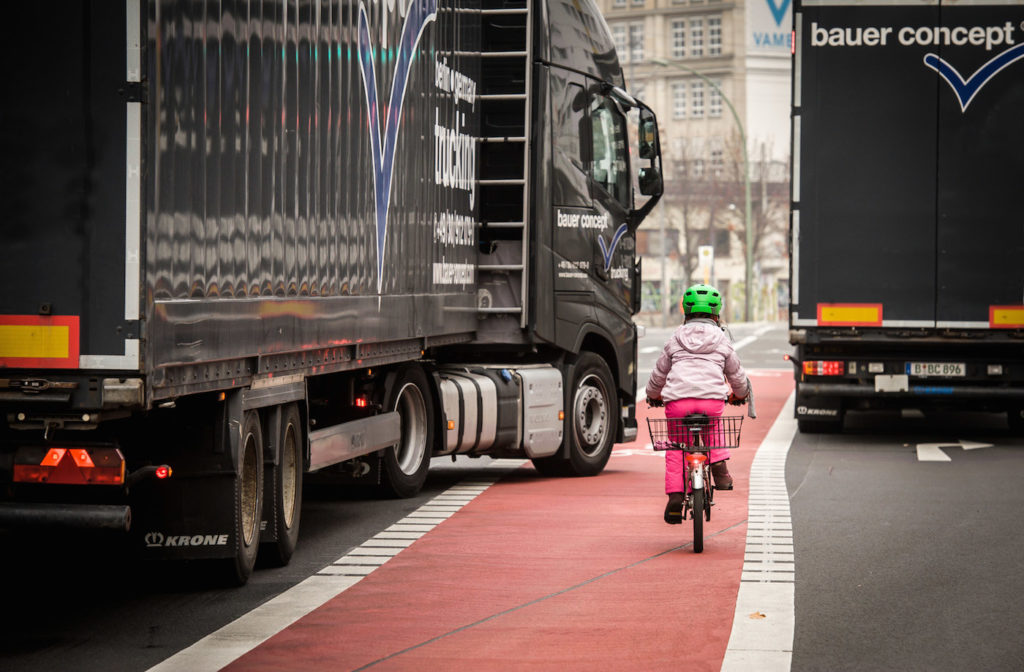
Berlin, 26 November 2018 – Changing Cities, the organizer of the Berlin Bicycle Referendum, shows in an unnerving demonstration with children cycling between gigantic eighteen-wheelers reveal how dangerous poorly designed bike lanes can be.
Two weeks ago, the first protected bike lane in Germany was inaugurated in Berlin by the local senator of environment and traffic, Regine Günther. Bike activists from Changing Cities, who initiated Germany’s first bicycle law, applauded the measure. However, while the bike lane itself is a major improvement, it became obvious that the intersection directly adjacent is a dangerous end. Motor vehicles wanting to turn right, will now need to cross the bike lane at high speed.
Conflicts involving right turns at intersections are one of the major challenges traffic designers are faced with. The current Berlin approach, a bike lane switch point, simply shifts the setting of this conflict away from the intersection. Cars and cyclists have to merge into the right lane long before slowing down. Cars and trucks have to cross the cycle lane, which goes straight through the intersection, leaving cyclists sandwiched between motorized vehicles.
The activists reenacted this conflict with two eighteen-wheelers and cycling children showing the fatal interlacing of different traffic flows. The contrast between the enormous vehicles and the small child emphasize the problem. “Protected bike lanes need protected intersections.The Dutch have known how to solve this problem for a long time”, argues Jens Blume from Changing Cities. “I would never let my children ride a bike here, it’s simply too dangerous!”.
Changing Cities is calling for a stop of building this type of bike lane switch and demands existing ones to be redesigned.
With their protest, the activists illustrated the importance of integrating all groups affected before designing the city streets. “Bike lane switches are still seen as the new and safe solution. If cyclists and pedestrians were included in the planning and designing of the road, these dangerous bike lanes would never have been built!”, Alexandra Meyer, the speaker of the local Bike Friendly Network Berlin-Mitte, said.
In Berlin, consultations concerning the so-called Cyclist Traffic Plan are currently taking place. The Cyclist Traffic Plan is a sub-legislative administrative guideline that specifies how infrastructure required by the Berlin Bicycle Law, passed in June, will be translated into standards usable for the administration. These standards will finally define the street design. “The contents of this crucial plan will include decisions, such as where will the new bike lanes be built? How many bike parking spaces will be set up? How do we practically reduce the number of traffic deaths in Berlin from 38 this year to zero? Or how does a safe intersection exactly look like”, says Angelo Bienek from Changing Cities.
Press contact by Changing Cities e. V.:
Ragnhild Sørensen, ragnhild.soerensen@changing-cities.de, +49 171 535 77 34
Further information:
Pictures from the enactment for free use
The Berlin Act of Mobility from 28th June 2018 (in German)
Informations about Changing Cities e.V.
Informations about the Berlin Cycle referendum
About Changing Cities e.V.: The Changing Cities movement works to transform urban mobility and transport policy in Germany from below. We engage ourselves for cities that are more accessible, democratic, sustainable, and safe for all. Through our campaigns, we have initiated systemic change by creating a new law on mobility in Berlin. In 13 other cities, local movements have followed our path and started “Radentscheide” (cycling referendums). of the of the 2021 German federal elections.